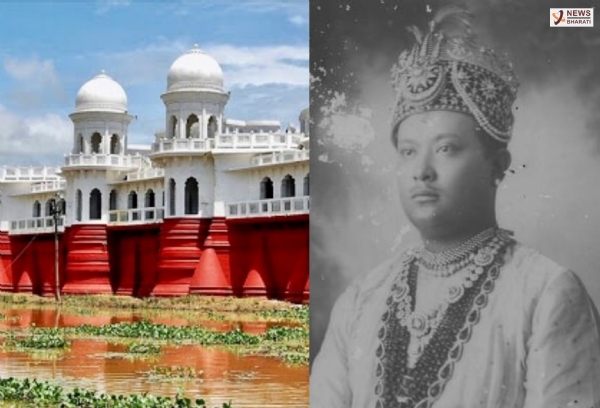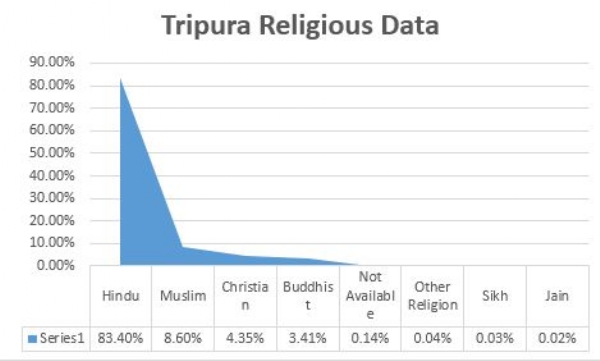Maharaja Bir Bikram Kishore Manikya: Hindu ruler of the Hindu state of Tripura
At the time of India"s independence, Tripura was a princely state with a Hindu majority ruled by Maharaja Bir Bikram. He signed the instrument of accession on October 15, 1949, which made Tripura a part of India.
Total Views |
Tripura Chief Minister Dr Manik Saha recently unveiled the statue of Maharaja Bir Bikram Kishore Manikya in Agartala. The statue of the king was unveiled on Friday (Mar 31) at the Zero Milestone near Kaman Chowmuhani in Agartala near the Maharaja Bir Bikram International Airport. On the occasion, Zero Milestone was also renamed as Maharaja Bir Bikram Chowmuhani.

In a series of tweets, Tripura Chief Minister Manik Saha said, "Today is a very proud day for Agartala residents. In honour of Maharaja Beer Bikram Manikya Bahadur Ji, shaper of modern Tripura we raise Chaumuhani and Marmar statues named after him today". He further mentioned that with the unveiling of this statue, a long pending demand of the people of Agartala has been fulfilled.
"A long-standing wish has been fulfilled today with the inauguration of this newly created zero milestone and Chaumuhani named after Maharaja Bir Bikram," he tweeted. In this regard, the official media handle of BJP Tripura also took to Twitter and said, "Today is a day of great pride for the people of Tripura. Chaumuhani and Marmar statues are named after him in honour of Maharaja Bir Bikram Manikya Bahadur Ji a shaper of modern Tripura. A newly decorated zero milestone was inaugurated today by Chief Minister Dr Manik Saha".
Who was Maharaja Bir Bikram?
Maharaja Bir Bikram Kishore Manikya Bahadur was a king of the Tripura. He was born on Aug18, 1908, and ascended to the throne on May 18, 1923, at the age of 15. Maharaja Bir Bikram is known for his contributions to the modernization and development of Tripura.
During his reign, Maharaja Bir Bikram initiated a number of reforms aimed at improving the lives of his subjects. He introduced measures to promote education, healthcare, and agriculture, and invested in the development of infrastructure such as roads, bridges, and railways. He also encouraged the growth of industries and trade in Tripura.
Maharaja Bir Bikram was a patron of the arts and culture, and supported the preservation of Tripura's rich cultural heritage. He was a visionary leader and is remembered as one of the most popular and respected kings of Tripura.
Maharaja Bir Bikram was the ruler of Tripura during independence of India in 1947. Maharaja Bir Bikram supported the merger of Tripura into India in 1947. He recognized the benefits of joining India and worked closely with the Indian govt to facilitate the integration process.
At the time of India's independence, Tripura was a princely state with a Hindu majority ruled by Maharaja Bir Bikram. He signed the instrument of accession on October 15, 1949, which made Tripura a part of India. Maharaja Bir Bikram played an important role in ensuring a smooth and peaceful integration of Tripura into India. After the merger, Maharaja Bir Bikram served as the first Chief Minister of Tripura from July 1, 1949, until his death on May 17, 1947.
আজ আগরতলা বাসীর জন্য অত্যন্ত গর্বের একটি দিন।
— Prof.(Dr.) Manik Saha (@DrManikSaha2) March 31, 2023
নবরূপে সজ্জিত শূণ্য মাইলফলক এবং আধুনিক ত্রিপুরার রূপকার মহারাজা বীর বিক্রম মানিক্য বাহাদুর জী'র সম্মানার্থে তাঁর নামে নামাঙ্কিত চৌমুহনী এবং মর্মর মূর্তির উদ্ধোধন করি আজ। pic.twitter.com/wQQLnnGI2a
HINDU ruler of the HINDU majority state of Tripura
Maharaja Bir Bikram implemented several reforms aiming at promotion of Hindu dharma and improving the lives of the Hindu population in Tripura. He is known for renovating ancient and important Hindu temples in Tripura during his reign, including the famous Tripura Sundari Temple, which is one of the 51 Shakti Peethas of Hindu dharma.
Other than renovating temples, Maharaja Bir Bikram also constructed a ghat at a Hindu pilgrimage site called Akhaura, which is located on the Bangladesh-India border. The ghat provided easier access for Hindu pilgrims to take a holy dip in the river.
Maharaja Bir Bikram is recorded to have donated land for the construction of several Hindu temples and other religious institutions. The Hindu ruler encouraged the celebration of Hindu festivals and cultural events in Tripura and thus promoted Hindu culture. He also supported the study and promotion of Hindu literature and philosophy.
Maharaja Bir Bikram was a devout Hindu, who worked towards the promotion and development of Hindu dharma in Tripura.
History of Islamic invasions in Tripura
The region was under the rule of various Hindu kings for many centuries, and the first Muslim invasion of Tripura took place in the late 13th century when the region was under the rule of the Tripuri kings.
In the 16th century, the Mughal Emperor Akbar conquered Bengal, which included the region of Tripura. However, the Mughals did not establish a strong presence in Tripura, and the region remained largely under the control of the Tripuri kings.
In the 18th century, Tripura was invaded by the Burmese, who captured the capital city and ruled the region for many years. Later, in the 19th century, the British East India Company gained control over Tripura.
Still continues to remain a 'Hindu' majority state..but about tomorrow?

Data as per Election Commission of India
Today when we look at the demographics of the state of Tripura, an ongoing shift is observed in the religious composition of the state. The population of Tripura, even today, is predominantly Hindu, with approximately 83 per cent of the population practicing Hinduism. However, there is also a significant population of Christians and Muslims in the state.
The Christian population is mostly concentrated in the northern and western parts of the state, while the Muslim population is mainly found in urban areas. The remaining population practices other religions such as Buddhism, Jainism, and tribal religions. There have been incidents of mass Christian conversions in Tripura in the past. There have also been allegations of forced conversions by Christian missionaries in some tribal areas of the state, which have been denied by the Christian organizations.
The concentration of the Muslim population in urban areas in Tripura is mainly due to migration and economic opportunities. Many Muslims from neighboring Bangladesh have migrated to Tripura over the years, especially during the 1971 Bangladesh Liberation War. These migrants settled mostly in urban areas, such as Agartala, the capital city of Tripura, and other major towns in the state, that has resulted in the demographic shift in the state.
However, there also have been reports of forced conversions to Islam in Tripura. In consideration of such incidents, the state has witnessed several activities in the recent years demanding stringent laws in protection of people's Freedom of Religion. Hindu Jagaran Mancha's protests in 2020, ahead of the lockdowns, demanding an effective law to curb increasing ‘love jihad’ cases remains the biggest such demand in recent years in the state.
“India's north eastern states are losing their Hindu identities and their cultural belonging to Hindu Dharma is fading due to the convincing portrayal of particularly Christian Missionaries that the North Eastern Tribal Communities are different from the Hindu community. In such circumstances, efforts to revive the region's Hindu roots play a vital role. The initiative to install the statue of great Maharaja Bir Bikram Kishore Manikya is a similar effort.”
--



